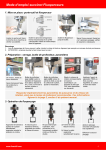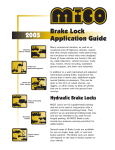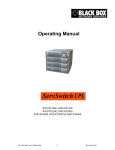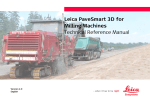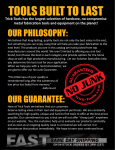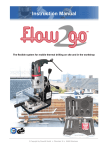Download User guide
Transcript
User guide All rights reserved. No part of this publication may be reproduced or transmitted in any form or by any means, electronic or mechanical, including photocopy, recording or any information storage and retrieval system, without permission in writing from the publisher. This handbook has been carefully prepared and translated. Flowdrill does not accept any responsibility for errors in the handbook and any consequences resultant therefrom. No guarantee can be given that the details are free from patent rights assigned to third parties. All data and comparative details should be understood as being indicative without obligation. Because Flowdrill friction drilling procedures are continuously being further developed, the details given may not provide any indication of the current state of development, availability or possibilities of delivery. The producer's current lists should be consulted for information. Copyright by FLOWDRILL B.V. HOLLAND Edition 2003 FLOWDRILL B.V. INDUSTRIETERREIN "LAGE WEIDE" SAVANNAHWEG 70 NL 3542 AW UTRECHT TEL: 31-30-2416606 FAX: 31-30-2413860 Email address: [email protected] URL: http://www.Flowdrill.nl We care about the (w)hole Flowdrill ® is the registered trade mark of Flowdrill b.v. Holland Table of Contents 1 Equipment for the Flowdrill® system 1.0 History 2.0 Introduction 3.0 Flowdrill - Ideal for automation 4.0 How the Flowdrill works 5.0 Flowdrill parameters 6.0 Flowdrill types 7.0 Applications of Flowdrills 8.0 Suitable materials 9.0 Working life - Influential factors 10.0 Work-piece material and lubrication 11.0 Tapping information 12.0 Flowdrill process with CNC 13.0 Starter Set 14.0 Parameters for metric thread tools 15.0 Tables of torque and pull strength 16.0 Maximum material thickness for thread holes 17.0 Hints & Tips 18.0 Thread tables The Flowdrill ® System 2 The Flowdrill ® System 3 Toolholder with Nut, Spanner and "C" Spanner -FDMC2 -FDMC3 Collets -Fd 430e 6 up till 14 -Fd 470e 12 up till 20 -Rubber flex collets Flowdrills and Flowtaps -Standard (see cover at the back) -Specials Lubricants and Miscellaneous 1.0 History 0,5h 3à4xh In 1923, in a little barn in the south of France, Jan Claude de Valliere attempted to develop a tool for producing holes in thin steel sheet using the principle of frictional heat instead of cutting. After many experiments, he was technically successful. h 4 D1 fig. 1 However, practical industrial applications were not possible, because: - Very hard material such as tungsten carbide was not available. - Correct geometry of the tools was not known. - Diamond grinding wheels for hard materials did not exist. - Machinery to generate the required complicated profile were not available. fig. 2a It would take almost 60 years before these problems could be solved and the Flowdrill could find its way to successful commercial use. fig. 2b fig. 2c fig. 2d 2.0 Introduction 5 A Flowdrill(fig.3) is a lobed, conical tungsten carbide tool. When rotated at high speed and pressed with high axial force into sheet metal or thin walled tube, generated heat softens the metal and allows the drill to feed forward, produce a hole and simultaneously form a bushing from the displaced material (fig. 1). There are numerous possible applications for Flowdrill; it increases effective wall thickness for threaded connections or soldered joints etc. (fig. 2a-f). Shank Collar Cylindrical part Conical part Flowdrill point 2a Chipless drilled hole for spraying appliances. No chips, no broken drills. 2b Gas tight connection 2c Threaded connection around the hole with rim fig. 3 2d Threaded connection (Flat face) 2e Bearing or shaft support 2f Water tight + soldering high pressure fig. 2e fig. 2e fig. 2f 3.0 Flowdrill® - Ideal for Automation 6 (a) No swarf lighting and household appliance industries, etc. (b) Long tool life Although the process itself has been applied for some time, it is necessary for the user to understand the nature of the Flowdrill process, the various types of Flowdrills and the physical requirements of the drilling machine for best Much experience has been gained in the automobile, gas-heating, metal furniture,results. (c) Accurate hole form Automatic Turret drilling Head suitable for any column drilling machine 4.0 How the Flowdrill® works 7 The standard Flowdrill design is shownof the drill feed. in figure 3. Its working portion consists As the material softens, axial force is of a pointed end, a cone and a parallelreduced and feed rate increased (fig. 4 body. Both the cone and the body ared,e,f,g,h). polygon shaped. This specially designed shape plays an essential part Final size and shape of the Flowdrilled in the Flowdrill process. The Flowdrill hole and bushing are determined by the also has a collar and a straight shank.diameter and cone shape of the Flowdrills are made of a carbide gradeFlowdrill. developed to satisfy the unique charac-Material that flows back towards the teristics of the Flowdrill operation. Flowdrill can be formed into a collar (fig. 4 i) or cut off flush to the surface 4.1 The phases of Flowdrill with a 'flat' type Flowdrill (fig. 4 k). 4.1.3 High axial force: 4.1.1 Initial Contact - Develops heat rapidly in Flowdrill Relatively high axial pressure ( F. ax), creating thermal stress. combined with high rotational speed is- Increases feed rate - reduces drilling needed to generate heat between Flowdrill time. and workpiece (fig. 4 a,b,c). - May alter the physical properties of The Flowdrill temperature rises rapidly to workpiece material. about 650 - 750 º C. and the w orkpiece 600 º C 4.1.4 Low axial force: . High axial force is needed until the Flowdrill point penetrates the material. - Provides gradual warming, reducing stress in Flowdrill. 4.1.2 Material Flow - Increases drilling time which can result in excessively high temperatures. Displaced material initially flows up - Reduces torque on Flowdrill. towards the Flowdrill; when the point - Requires less power input. penetrates, material flows in the direction fig. 4a fig. 4b fig. 4c 8 f ig. 4d f ig. 4e f ig. 4f f ig. 4g f ig. 4h f ig. 4i f ig. 4j f ig. 4k 5.0 Flowdrill® parameters 9 The Flowdrill diameter determines values for: Axial forces F ax (N) Speed Rpm 5.2 Speed (n) See fig. 5a n(min-1) Power 5b P(kW) 5c Material thickness (max.) h(mm) 6 5.1 Axial force ( F. ax) Keep speed as low as possible to obtain longer Flowdrill life. Speed selection is influenced by material thickness as well as material type. Thicker stainless- and high carbon steel require lower speed and will usually result in shorter Flowdrill life. As a general rule, soft non-ferrous materials require more speed: the softer the material, the higher the speed. Maximum axial force is proportional to the Flowdrill diameter. As temperature increases, axial forceGraphics 5a, b, c, are based on Fe.360 required reduces, feed rate increases. h=2mm. F ax ( N ) 7000 6000 5000 4000 3000 2000 1000 1 2 3 4 5 6 7 8 9 fig. 5a 10 11 12 13 14 15 16 17 18 19 20 21 22 23 24 25mm. Flowdrill mm. 10 Rpm 7000 6000 5000 4000 3000 2000 1000 1 2 3 4 5 6 7 8 9 Ideale startpositie (zie hoofdstuk 14.0) fig. 5b 10 11 12 13 14 15 16 17 18 19 20 21 22 23 24 25mm. Flowdrill mm. Optimaal Flowdrill bewerkingsgebied Randgebieden met hogere Flowdrill slijtage 11 12 5.3 The effects of different speed 5.4 Power (kW) are shown in this example: Most good quality drilling machines are Material thickness (h) 2.0 mm 2.0 mm Flowdrill dia. 7.3mm 7.3mm Speed (n) 3 000 min- 1 1750 min-1 Drilling time 1. 5 sec. Flowdrill Temperature 700 º C 2.0 sec. 600 º C suitable for Flowdrill, provided they meet the power and speed requirements. The required power of the drilling machine is shown on chart (fig. 5c). 13 P kW 7 6 5 4 3 2 1 1 2 3 4 5 6 7 8 9 Optimum operation area mm. fig. 5c 10 11 12 13 14 15 16 17 18 19 20 21 22 23 24 25mm. Flowdrill 14 5.5 Material Thickness (h) Fig. 6 indicates maximum material thickness that can be Flowdrilled with Maximum material thickness (h.Max) is standard long or short Flowdrills. See also proportional to the Flowdrill diameter. table in chapter 16.0 Minimum thickness follows the general Special Flowdrills can be supplied to meet rule: h Min = approx. 0.2 x D 1 up to unusual needs. 2mm, which rule is suitable for most of For greater thickness an extra long L 5 the bigger sizes. D1 is the Flowdrill may be necessary. diameter. (Ask for advise) Flowdrill life is reduced if used on heavier gauge material or materials with high tensile strength. Notes: 15 When the application is outside the range of max. lines given in this graphic, please call our technical service for their experience h in mm. 10 9 8 7 6 5 4 3 2 Flowdrill type short for conical bushing type long for cylindrical bushing 1 1 2 3 4 5 6 7 8 fig. 6 9 10 11 12 13 14 15 16 17 18 19 20 21 22 23 24 25mm. Max. short for conical bushing Max. short flat for conical bushing Max. long for cylindrical bushing Max. long for conical bushing Max. long flat for conical bushing Flowdrill mm. 6.0 Flowdrill® types 16 6.1 Long Flowdrill (fig. 7a) The long Flowdrill has a long parallel body (L5)(fig.7) designed to produce a hole that is cylindrical for the entire bush length. Material that is backward extruded is rolled into a rim by the Flowdrill collar (fig. 8e). 6.2 Short Flowdrill (fig. 7b) Short Flowdrills have a shorter parallel body. This design produces a bush that is conical and provides great strength when formed into a thread (fig. 8a). fig. 7a 6.3 Short Special Flowdrill (fig. 7c) Special L 4 & L 5 dimensions are available for use when Flowdrill penetration length is restricted for example in small diameter tube. fig. 7b fig. 7 fig. 7c 17 6.4 Optional Features The following optional features can be supplied on any Flowdrill: 6.4.1 Milling cutters "Flat Flowdrill" (fig. 7d) The Flowdrill collar is ground into a cutter (fig. 8c,g). This removes the rim formed around the top surface of a Flowdrilled hole, leaving the surface flat. fig . 7d 6.4.2 Fluted point "Rem Flowdrill" (fig.7e) Fluted point: all Flowdrills can be supplied with two small cutting flutes at the tip (fig. 8b,f). This style is useful for coated materials such as paint, anodised and some galvanised steel, depending on thickness of layer. The axial force is also reduced, permitting use in portable hand drills, or when a work-piece has insufficient support in the area to be Flowdrilled and tends to dent , due to insufficient rigidity. fig. 7e 6.4.3 Flat Rem (fig.7f) All Flowdrills can be supplied with combination of cutting flutes and milling cutters (fig. 8d,h). fig. 7f 18 8a. short 8b. short rem 8c. short flat 8d. short flat rem 19 8e. long 8f. long rem 8g. long flat 8h. long flat rem 7.0 Applications of Flowdrills 20 7.1 Flowtapping 7.1.2 Example The most common use of Flowdrills isM6 in 2 mm Fe 360 to provide a high strength threaded fastener in thin sheet metal or tube. AUse Flowdrill: FD - 5.3 short Flowdrilled hole may be tapped with conventional cutting taps or preferably,Use Flowtap FT - M6 with cold form Flowtaps. Flowtapping resembles Flowdrill except the opera-Thread strength 17 kN. ting temperature is much lower; instead of cutting, Flowtaps cold-form the thread(no swarf). The diameter of the Flowdrill determines the final thread form,-depth and -strength. Tables in chapter 18.0 (back cover) show the recommended Flowdrill diameters for various thread sizes. 7.1.1 Advantages of Flowtaps compared with thread cutting taps - No weakening of the threaded wall due to metal removal. - Higher production speed. - Better thread strength through cold forming of the material. - Less chance of pitch errors that can be incurred when cutting threads. - No swarf, no pollution or chip removal problems. - Less tap breakage. - Good tap life. 21 7.2 OtherApplications Bearing support ( f ig. 2e) Soldered connection ( f ig. 2f) f ig. 2e fig. 2f 8.0 Suitable materials 22 2 8.1 Steel (up to 700 N/mm tensile strength). 8.2 Non-ferrous metals (with the exception of brittle CuZn40Pb2). material, like 8.3 Aluminium with less than 5% Si. 8.4 Stainless steel, acid resistant steel. In some cases it is desirable to test the suitability of the Flowdrill system. In particular in case of zinc coated materials. 9.0 Working Life - Influential factors 23 9.1 Flowdrills are made of specially 9.10 Flowdrill temperature should not developed carbide. This will maintainexceed dark red colour. its strength at high temperatures but is sensitive to thermal stress. Local9.11 Speed and axial force should be cooling should be avoided. adjusted optimally under observation of the temperature of the FD (indicated by 9.2 Flowdrills cannot withstand high dark red colour). mechanical shock. They should not be dropped and hard impact onto the9.12 Hole quality will be affected by surface of the workpiece, as well asbuild up of work-piece metal on the tool, welded spots should be avoided. also from film caused by anodised aluminium or zinc from galvanising. 9.3 Avoid radial forces on the Flowdrill 9.13 Timely removal of built up material 9.4 Torsional stability of the Flowdrill with diamond file is important. Too rapid release of torsional load caused by fast break through 9.14 Cleaning with a diamond file will (very high feed rate) can cause fatigue. extend tool life. 9.5 A similar condition can occur due to9.15 Don't dwell at depth when using wind up if start pressure is too great. Flowdrills - especially flat Flowdrills dwelling reduces cutter life. 9.6 DO NOT DRILL an unfinished hole, risking taper lock due to shrink-9.16 Protect the Flowdrill and drilling age. machine spindle for overheating by using the special Flowdrill toolholder with cool9.7 Instability due to wear in machine ing fan. spindle or collet can allow the Flowdrill to wander. Stress caused by misalignment can break the Flowdrill. 9.8 Finish -quality- in the Flowdrilled hole will deteriorate when the Flowdrill becomes worn. 9.9 Regular lubrication will increase life of Flowdrill. Use Fdks for lubrication of the FD every 1-5 holes on the hot rotating FD. 10.0 Work-piece material and lubrication 24 Flowdrill lubrication Flowdrill results depend on the material's physical properties, such as tensile strength, hardness, chemical content and conductivity. Generally all malleable materials can be Flowdrilled. Lubrication of the Flowdrill can work against the need to generate heat but is required in small amounts to prevent pick-up or adhesion on the carbide surface, particularly when Flowdrilling aluminium. Flowdrill lubricants are specially developed to meet this criterion. 10.1 Remark Lubricate while Flowdrill is still running, directly after Flowdrill operation. 10.2 Flowdrill lubricants FDKS paste and FDKS fluid to use for drilling in steel, stainless steel, copper and brass. FDUN paste to use for drilling in aluminium. 10.3 Tapping lubrication High material deformation during tapping places strong demands on the lubricant used. To obtain optimum speed and quality we recommend use of Flowdrill FTMZ high pressure lubricant. It should be applied for each hole tapped. Dispensers are available for automatic production. Avoid overheating the lubricant. 25 11.0 Tapping mation 11.0 Tapping infor information 26 11. 1 Tapping Torque 11.3 Recommended Flowdrill dia- The torque required for tapping (coldmeters for tapping (backcover) forming) threads depends on theRecommended Flowdrill diameters Flowdrill diameter, Rpm, work-piece produce 65% thread depth. material and lubrication. Because the cold forming process tougCold forming threads generally usehens the material, thread strength is about 20 % more torque than cutting.greater than when a cutting tap is used However, the conical hole shape gene(fig. 11a). rated to give maximum thread strengthLarger Flowdrill diameters have a in a Flowdrilled bushing can double thefavourable effect on Flowtap life. torque required (fig. 11b). They may also be advantageous in some very tough materials or materials 11.2 Flowtap speed (fig. 11c) that tend to recover or shrink after forming (for example M 6 thread can See also chapter 14.0. be formed using 5.3 - 5.4 - 5.5 Flowdrill, depending on conditions) fig. 11a Required torque is dependant on the: - Roughbore diameter - Rpm - Pitch - Lubrication Influence of roughbore roughbor diameter on the torque torqu 27 Rpm 100 200 400 600 800 1000 kW Torque Nm 304 Fe 360 Cu in Fe 360 RPM Nm kWatt Example M10 200 10 0,2 Threaddiameter in mm. 12.0 Flowdrill® process with CNC 28 A4 Material: Mild Steel (ST37) Material thickness: 3 mm FEED RATE - mm / minute CNC-PROGRAM TIME WORKING PART (Zeit) (Weg) FEED RATE (Vorschub) 2.73 0 - 2 mm 2 - 4 mm 4 - 7 mm 7 - 11 mm 11 - 14 mm 14 - 18 mm 150 mm/ min 250 mm/ min 350 mm/ min 550 mm/ min 700 mm/ min 1000 mm/ min 1000 950 900 850 800 750 700 650 600 550 500 450 400 350 300 250 200 150 100 50 0 0 1 2 3 4 5 6 7 8 9 10 11 12 13 14 Tool Size 15 16 17 18 19 20 21 22 23 Tool Type 25 Drawing Number FD 7.3 (L1 = 18mm - L4 = 10mm ) Long / Flat TOOL WORKING PART - mm 24 A4 000 Size Job No 00000 00 P.L No 00 00 Detail Issue A Flowdrill's feed rate is determined byrate. pressure - initial pressure is quite high,Feed and rates of acceleration will vary to create frictional heating. As the workaccording to Flowdrill size, Flowdrill piece softens, it allows the drill to speed, material type and thickness, but advance, the rate of advance increases correct feed can be established fairly with heating and also as the drill pointeasily by trial and observation. The aim penetrates through the material. is to achieve and maintain a constant The required accelerating feed rate can dull red glow while the tool is drilling. be achieved by hand or with pneumatic feed devices. Example of feed for 7.3 (M8) long/flat If CNC is to be used, this effect has toFlowdrill through 3.0mm thick mild be simulated with a slow initial feed steel. (As a guideline, depending on rate accelerating to a high final feedmachine and material) 13.0 Starter Set 29 A4 Material: Mild Steel (ST37) Material thickness: 3 mm FEED RATE - mm / minute CNC-PROGRAM 1000 950 900 850 800 750 700 650 600 550 500 450 400 350 300 250 200 150 100 50 0 0 1 TIME (Zeit) WORKING PART (Weg) FEED RATE (Vorschub) 3.11 0 - 2 mm 2 - 4 mm 4 - 7 mm 7 - 11 mm 11 - 14 mm 14 - 16. 6 mm 150 250 350 550 700 250 2 3 4 5 6 1.4 mm space (adjustable) for rim or boss forming (Page 16 section 6.1) mm/ min mm/ min mm/ min mm/ min mm/ min mm/ min 7 8 14 9 10 11 12 13 14 15 16 17 18 19 20 21 22 23 24 25 TOOL WORKING PART - mm Tool Size Tool Type FD 7.3 (L1 = 18mm - L4 = 10mm ) Long/Standard A4 Size Example M8, Fe 360 3mm: Drawing Number 000 Job No 00000 00 P.L No 00 00 Detail Issue 13.9 Reduction cone 3-2 (optional extra) 13.1 Flowdrill 7.3 long (average life 13.10 Diamond file (optional extra) approx. 10,000 holes) 13.11 Ejecting drift key (optional extra) 13.2 Flowdrill lubricant Fd ks paste 13.3 Toolholder FD MC2 (locking spanners included) 13.4 Collet Fd 430E-8 13.5 Flowtap M8 (average life approx. 10,000 holes) 13.6 Flowtap lubricant Ft mz 13.7 FD-Case (keeps kit together) 13.8 Tapping extra) attachment (optional 30 14.0 Parameters for metric thread tools M 12 M 10 M8 M6 M5 M4 M3 M 2 14.8 10.9 9.2 7.3 5.3 4.5 3.7 2.7 1.8 Flowdrill Diameter mm 1200 1400 1800 2000 2200 2400 2500 2600 3000 3200 Flowdrill Rpm 2.7 2.2 1.7 1.5 1.3 1.0 0.8 0.7 0.6 0.5 Motor capacity kW. 5 4 3 3 2 2 2 2 2 2 Production time sec. 200 250 330 400 500 650 800 1000 1350 1600 Flowtap Rpm Mild steel FE 360 2mm. Indication to start with M 16 18.7 Thread size M 20 15.0 Tables of torque and pull strength 31 9s 6s Thread M4 10 s 13 s 15 s M5 16 s 17 s 24 s M6 27 s 37 l 45 l s=Short Flowdrill l=Long Flowdrill M8 Pull out strength in [kN] 1kN=100Kg. Material: Fe 360 Thickness: 1.0 - 5.0 mm Material Thickness h=mm 1.0 1.5 2.0 3.0 4.0 5.0 Thread Size 5 M4 M5 9 8 11 13 17 20 27 M6 Torque in [Nm] Material: Fe 360 Thickness: 1.0 - 5.0 mm Material Thickness h=mm 1.0 1.5 2.0 3.0 4.0 5.0 28 50 67 M8 52 l 68 l M10 66 98 M10 67 l 86 l 106 l M12 136 163 269 M12 97 s 115 l 141 l M16 197 M16 142 s 162 s >200 s M20 32 16.0 Maximum material thickness for thread holes Thread Max. material thickness Total length working part Flowdrill diameter for Flowtapping Short Short/Flat Long Long/Flat Shaft Ø Short Long M2 M2.5 M3 M4 M4 x 0.5 1.8 2.3 2.7 3.7 3.8 1.6 1.6 1.7 1.8 1.8 1.8 1.9 2.0 2.2 2.2 2.2 2.3 2.4 2.6 2.6 3.2 3.5 3.7 4.2 4.2 6 6 6 6 6 5.8 6.1 6.7 8.1 8.2 7.8 8.1 8.7 10.3 10.5 M5 M5 x 0.5 M6 M6 x 0.75 M6 x 0.5 4.5 4.8 5.3 5.6 5.8 1.9 1.9 2.0 2.0 2.0 2.4 2.4 2.5 2.5 2.6 2.7 2.7 2.9 2.9 3.0 4.6 4.7 5.0 5.0 5.2 6 6 6 6 6 9.2 9.6 10.3 10.8 11.2 11.8 12.4 13.5 14.2 14.7 M8 M8x 1 M8 x 0.75 M10 M10 x 1.25 7.3 7.5 7.6 9.2 9.3 2.2 2.3 2.3 2.6 2.6 2.9 2.9 2.9 3.2 3.3 3.3 3.4 3.4 3.7 3.7 5.9 6.0 6.0 6.6 6.7 8 8 8 10 10 13.5 14.0 14.1 16.8 17.0 18.1 18.7 18.8 22.5 22.8 M10 x 1 M12 M12 x 1.5 M12 x 1 M14 9.5 10.9 11.2 11.5 13.0 2.6 2.8 2.8 2.9 3.0 3.3 3.5 3.6 3.6 3.9 3.8 4.0 4.1 4.2 4.5 6.7 7.2 7.3 7.3 7.9 10 12 12 12 14 17.3 19.8 20.3 20.8 23.5 23.2 26.4 27.1 27.8 31.3 M14 x 1.5 M16 M16 x 1.5 M18 M18 x 1 13.2 14.8 15.2 16.7 17.5 3.1 3.3 3.4 3.5 3.7 4.0 4.2 4.3 4.6 4.8 4.6 4.8 4.9 5.2 5.6 8.0 8.5 8.7 9.2 9.5 14 16 16 18 18 23.8 26.9 27.6 30.4 31.9 31.6 35.4 36.3 39.7 41.5 M 20 M 20 x 1.5 M 20 x 1 G1/16 G1/8 18.7 19.2 19.5 7.3 9.2 3.8 3.9 3.9 2.3 2.6 5.0 5.1 5.2 2.9 3.2 5.7 5.8 5.8 3.3 3.7 9.9 10.0 10.0 5.9 6.6 18 18 18 8 10 34.1 35.1 35.6 13.5 16.8 44.3 45.5 46.2 18.1 22.5 G1/4 G3/8 G1/2 G3/4 12.4 15.9 19.9 25.4 2.9 3.4 4.0 4.8 3.8 4.5 5.2 6.2 4.3 5.0 5.9 7.0 7.8 8.9 10.0 10.4 12 16 18 20 22.4 28.9 36.3 46.4 29.8 37.9 47.0 59.6 Data based on Fe 360 17.0 Hints & Tips 33 17.1 Observation in process Possible Causes Flowdrill point wanders Worn Machine Spindle, (can break Flowdrill) Bearings Worn collet Excessive start pressure Spindle speed too low Flowdrill overheating Colour bright red Flowdrill sparkles Spindle speed too high Feed rate too slow 17.2 Observation on Work-piece Split collar (daisy petals) Start pressure/feed too high or spindle speed too slow or final feed to slow. Pilot hole or Rem FD may help Flash or burr on edge of Drill point wanders collar Excessive discoloration Feed too slow or spindle around hole speed too high 17.3 Cycle Time A guide to process speed for 2 mm Fe 360 is: 1 second + 1 second for each millimetre of material thickness i.e. Flowdrill time is 3 sec. approx. This guide can be used up to about diam. 12mm. Larger Flowdrills take longer but cycle time should not exceed 15 seconds. 17.3.1 Operation examples M8 M6 2400 Rpm 2200 800 N F. ax 1000 N 0.75 kW Motor capacity 1 kW 1.5 - 2 sec. Operation time 2 - 3 sec. 1.0 mm Material Thickness 2.0 mm 17.4 Flowtaps Consult the cover of this technical guide for the right diameter. 17.5 Check the table chapter 14.0 for the right speed. 17.6 Lubricate before every action, the Flowtap as well as the bush 18.0 Thread tables Metric thread Thread Pitch/mm M2 M 2.5 M3 M4 M5 M6 M8 M 10 M 12 M 16 M 20 0.4 0.45 0.5 0.7 0.8 1.0 1.25 1.5 1.75 2.0 2.5 Thread Pitch/mm M4 M5 M6 M6 M8 M8 M 10 M 10 M 12 M 12 M 16 M 16 M 20 M 20 0.5 0.5 0.75 0.5 1.0 0.75 1.25 1.0 1.5 1.0 1.5 1.0 1.5 1.0 US thread UNC Flowdrill diameter 1.8 2.3 2.7 3.7 4.5 5.3(5.4) 7.3(7.4) 9.2 10.9 14.8 18.7 Thread No. 4 No. 5 No. 6 No. 8 No. 10 No. 12 1/4 5/16 3/8 7/16 1/2 9/16 5/8 3/4 Metric thread fine G 1/16" G 1/8" G 1/4" G 3/8" G 1/2" G 3/4" G 1" Thread per inch 28 28 19 19 14 14 11 Flowdrill diameter 2.5 2.9 3.1 3.8 4.3 4.9 5.7 7.2 8.7 10.2 11.7 13.2 14.7 17.8 40 40 32 32 24 24 20 18 16 14 13 12 11 10 US thread UNF Flowdrill diameter 3.8 4.8 5.6 5.8 7.5 7.6 9.3 9.5 11.2 11.5 15.2 15.5 19.2 19.5 Thread No. 4 No. 5 No. 6 No. 8 No. 10 No. 12 1/4 5/16 3/8 7/16 1/2 9/16 5/8 3/4 BSP thread Thread Thread per inch Thread per inch Flowdrill diameter 2.6 2.9 3.2 3.9 4.4 5.0 5.9 7.4 9.0 10.4 12.1 13.6 15.2 18.3 48 44 40 36 32 28 28 24 24 20 20 18 18 16 US thread NPT Flowdrill diameter Thread Thread per inch Flowdrill diameter 7.3 9.2 12.4 15.9 19.9 25.4 31.9 1/16" 1/8" 1/4" 3/8" 1/2" 3/4" 1" 27 27 18 18 14 14 11.5 7.0 9.4 12.4 15.8 19.6 24.9 31.4 Sizes based on Fe 360 2mm Thicker material or material with greater tensile strength (stainless) Flowdrill diameter 0.1 mm bigger





































